| Andrew Chatto (b. 1841 - d. 1913) began his career in publishing at age fifteen as an apprentice in the publishing firm of John Camden Hotten. He was a partner in the firm when Hotten died in 1873. Chatto formed a new partnership with W. E. Windus and purchased the firm from Hotten's widow and worked hard establishing a reputation for fairness and improving relationships with authors Hotten had alienated, including Samuel Clemens. In 1875 Clemens broke with his former British publisher George A. Routledge and allowed Chatto to issue The Adventures of Tom Sawyer in England. Clemens liked the plans Chatto worked out for simultaneous publication of works in Britain and America that helped combat piracy of his works prior to the international copyright agreements of 1891. The Clemens and Chatto relationship was built on respect and grew into a friendship that endured throughout Clemens's lifetime. The Chatto and Windus publishing company continued to publish Mark Twain's works until 1969 when the firm merged with Jonathan Cape. | 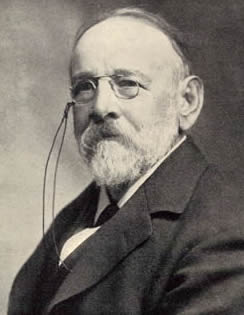 Andrew Chatto |
Chatto and Windus Red Cloth Uniform Editions
After 1875 Chatto published almost all of Mark Twain's works in Britain at the same time they were issued in America. Chatto also obtained rights to publish Mark Twain's works that had been released prior to 1875 such as The Innocents Abroad, Roughing It and The Gilded Age. Most Chatto and Windus editions contain texts that are identical to the American versions with some exceptions. In the case of Tom Sawyer Abroad (1894), Chatto prepared the British edition from a carbon copy of Clemens's original typescript. The American edition issued by Webster and Company used a magazine printing for the first portion of the book that had been heavily edited by Mary Mapes Dodge for St. Nicholas Magazine.
In the case of Following the Equator (1897) the Chatto edition is titled More Tramps Abroad and contains approximately 6,000 words that were cut from the American edition. However, it omits approximately 1,400 words that are contained in chapter 32 of Following the Equator. Chapter numberings and breaks between chapters differ slightly as well as the mix of the Puddn'head Wilson maxims that appear as chapter headings. Some Chatto and Windus volumes also feature the work of artists whose illustrations did not appear in the American editions..
Chatto aimed for uniformity in many of his Mark Twain first editions. This series of books feature bindings of red cloth with gold lettering on the spines and front covers with black stamped illustrations on the front..
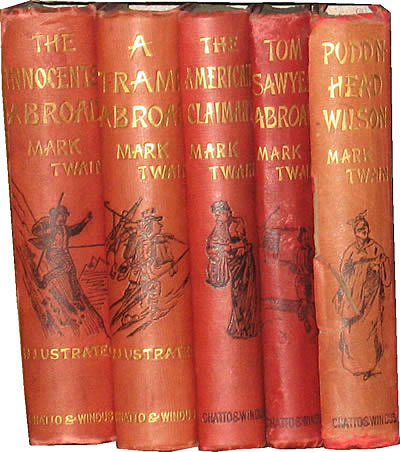 Photo courtesy of R. Kent Rasmussen |
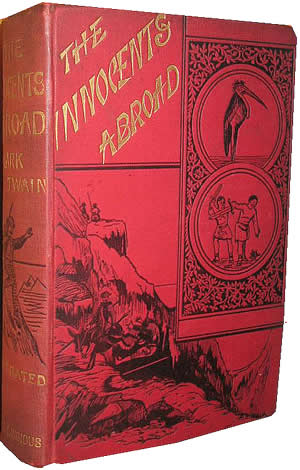 Covers featured illustrations from the text. |
Mark Twain's works issued by Chatto and Windus in this type of binding include the following titles. (Illustrators whose names appear after a title designate an artist whose work did not appear in the American editions of these same titles.)
Chatto and Windus Yellowbacks
Chatto included a number of Mark Twain's works in a series of cheap editions known in the book trade as Victorian yellowbacks, books that feature colorful paper wrappers pasted over boards for binding. These unillustrated books were priced at approximately two shillings. They were not designed to endure the test of time and few samples of these books have survived.
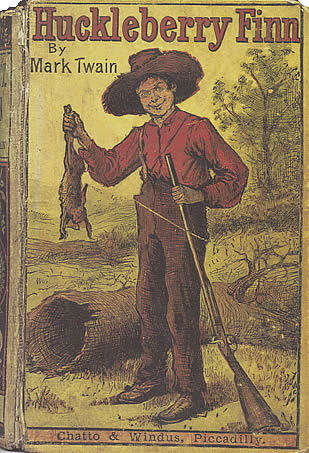 Yellowback edition of Huckleberry Finn |
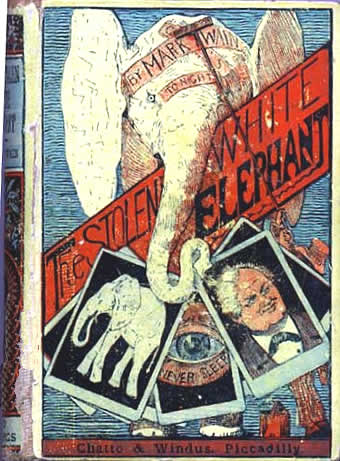 Yellowback edition of The Stolen White Elephant |
| The cheap Victorian yellowbacks were an additional option for British readers who wanted inexpensive collections of Mark Twain's works. Chatto sold advertising space on the backs of the books -- usually advertisements for Pears' Soap. No doubt the advertising revenue helped keep the prices of the books low. | 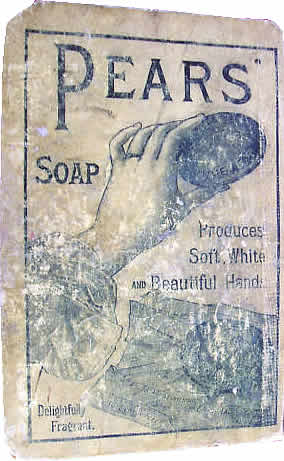 Advertisement for Pears Soap from the back of a cheap Mark Twain yellowback. |
Mark Twain's works issued by Chatto and Windus as yellowbacks are listed below. The publication dates are based on books found in private collections as well as Dennis Welland's study of the Chatto and Windus ledger books which often did not specify yellowback bindings. However, it appears that production numbers of the cheap yellowbacks may have surpassed the books bound in more expensive cloth bindings. The dates in parentheses below indicate the known publication dates of the yellowback editions.
Chatto and Windus Uniform Library Edition in Blue Cloth (1899)
Andrew Chatto agreed to market Mark Twain's autographed Author's Edition De Luxe published by American Publishing Company in Great Britain the same year he launched Chatto and Windus's own series called the Uniform Library Edition. His ads for both editions, as well as the cheap yellowbacks, appeared together in the terminal advertisements in books Chatto and Windus published in 1899.
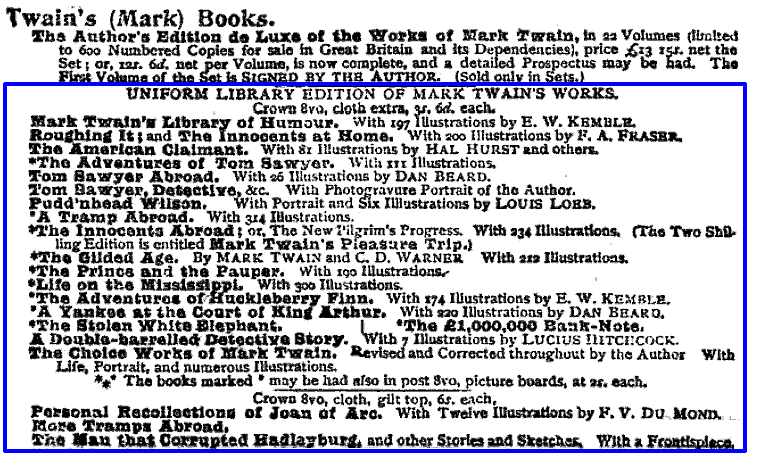
Ad from
Original Plays by William Schwenck Gilbert (Chatto and Windus, 1899)
lists prices indicating that the most expensive Chatto edition of Mark Twain's
books at 6 shillings was less than half of the 12 shillings and 6 pence
per book of the Author's Edition de Luxe.
Part of the reason for the failure of the sales of the autographed Author's Edition de Luxe set in Great Britain can be attributed to the lower prices of the Chatto books, in spite of the fact that Mark Twain's autograph was included in the higher priced sets.
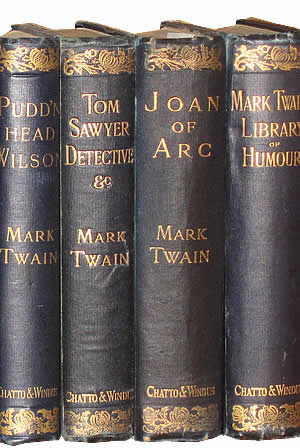 Photo courtesy of R. Kent Rasmussen |
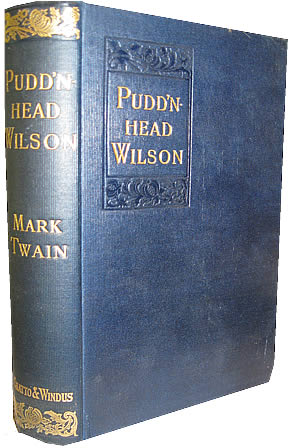 Covers feature gold stamped titles |
The Chatto and Windus blue cloth Uniform Library Edition featured gilt titles on the spine and covers. The books were not issued in sets and could be purchased individually. Measuring approximately 5" x 7 1/2" and priced at 3 shillings and 6 pence, they were slightly smaller than the autographed Author's Edition de Luxe volumes. But they were an extremely attractive and inexpensive alternative to the Author's Edition de Luxe set which sold for an average of 12 shillings and 6 pence per book. Chatto declined arrangements in the future to import other editions from American Publishing Company and later Harper and Brothers.

A rare 22-volume
set.
Photo courtesy of R. Kent Rasmussen
Twenty-two Mark Twain works were eventually issued by Chatto and Windus in this blue cloth binding and are listed below. For the most part, Chatto's editions contained the same contents as the American counterparts. However, there are exceptions. Chatto's edition of Tom Sawyer, Detective, published in 1897 differs from the American edition of the same name in that it featured the first collected appearance of the five short pieces "How to Tell a Story," "Mental Telegraphy Again," "What Paul Bourget Thinks of Us," "A Little Note to M. Paul Bourget," and "Adam's Diary."
Chatto's 1900 edition of The Man That Corrupted Hadleyburg contains "Christian Science and the Book of Mrs. Eddy" which would not be published by Harper and Brothers until 1907.
(Illustrators whose names appear after a title designate an artist whose work did not appear in the American editions of these same titles.)
Chatto and Windus Florida Edition (1925-28)
With the exception of Author's Edition De Luxe in 1899, Chatto's Mark Twain books were sold individually as a matching series. In 1925, however, Chatto and Windus began issuing the Florida Edition of Mark Twain's works. The set is uncommon and the only known library in the United States holding a complete set is the Harry Ransom Center at the University of Texas in Austin. In 1925 the Annual Bibliography of English Language and Literature described the set that would eventually include 18 volumes. The books measure 7 3/4" x 5" and sold for 6 shillings each. Five volumes were issued in 1925 and presumably, six or more a year would be issued through 1928. The books were bound in green library cloth with the title, author, and publisher stamped in gold lettering on the spine. The volumes are not numbered. The titles in this edition are:
_____
References
Rasmussen, R. Kent. Critical Companion to Mark Twain, Volumes I and II. (Facts on File, 2007).
Seaton, Ethel, et. al. Annual Bibliography of English Language and Literature, Volume VI, 1925. (Cambridge University Press, 1925). Online from google books.
Topp, Chester W. Victorian Yellowbacks and Paperbacks, 1849 - 1905, Volume III: John Camden Hotten and Chatto and Windus / Chapman and Hall. (Denver: Hermitage Antiquarian Bookshop, 1997).
Welland, Dennis. Mark Twain in England. (Chatto and Windus, 1978).